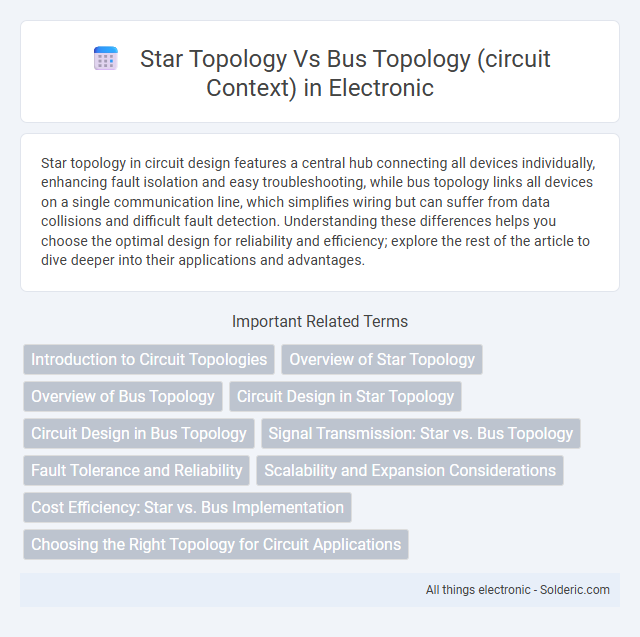Star topology in circuit design features a central hub connecting all devices individually, enhancing fault isolation and easy troubleshooting, while bus topology links all devices on a single communication line, which simplifies wiring but can suffer from data collisions and difficult fault detection. Understanding these differences helps you choose the optimal design for reliability and efficiency; explore the rest of the article to dive deeper into their applications and advantages.
Comparison Table
| Feature | Star Topology | Bus Topology |
|---|---|---|
| Structure | All devices connected to a central hub or switch | All devices connected to a single central communication line (bus) |
| Signal Path | Signals travel through the hub to reach devices | Signals travel along the single shared bus |
| Fault Tolerance | Failure of one device does not affect others; hub failure disrupts network | Failure of the main bus breaks the entire network |
| Installation Complexity | More complex due to multiple cables connecting to the hub | Simpler with a single communication line |
| Scalability | Easily scalable by adding devices at the hub | Limited scalability; adding devices can degrade performance |
| Data Collisions | Less prone due to centralized management | Higher collision risk due to shared communication medium |
| Cost | Higher cost due to cables and hub hardware | Lower cost with minimal cabling |
| Performance | Better performance with dedicated connections | Performance degrades with more devices |
Introduction to Circuit Topologies
Star topology features a central node connecting all devices, offering easy fault isolation and scalability in circuit design. Bus topology uses a single communication line shared among devices, reducing wiring complexity but risking total system failure if the main bus is disrupted. Understanding these configurations helps you choose the optimal layout for efficient signal transmission and maintenance in electronic circuits.
Overview of Star Topology
Star topology in circuit design features a central hub connecting multiple devices, allowing efficient data transmission and simplified fault detection. Each device links directly to the hub, minimizing data collision risks and enabling easy network management. Your system reliability improves as a failure in one connection does not disrupt the entire network.
Overview of Bus Topology
Bus topology in circuit design involves a single central communication line shared by all connected devices. Each device taps into the bus to send and receive signals, which simplifies wiring and reduces costs but can cause signal collisions and network interruptions. This topology suits small networks with low traffic but lacks the fault tolerance and scalability of star topology.
Circuit Design in Star Topology
Star topology in circuit design centralizes connections through a single hub, improving fault isolation and simplifying troubleshooting by localizing failures to individual branches. This architecture enhances signal integrity by minimizing collision domains and reducing the risk of data transmission errors compared to bus topology where all devices share a common communication line. Your circuit benefits from easier scalability and maintenance, as adding or removing components in a star configuration does not disrupt the entire network.
Circuit Design in Bus Topology
Bus topology in circuit design utilizes a single central communication line where all devices are connected, enabling straightforward wiring and reduced cable length. This design simplifies troubleshooting and is cost-effective for small networks; however, signal degradation and data collisions can occur as more devices connect, impacting performance. Understanding these trade-offs helps you optimize your circuit layout for scalability and reliability.
Signal Transmission: Star vs. Bus Topology
In star topology, signal transmission occurs through a central hub, which manages data flow and reduces the chances of signal collision, leading to more reliable communication. Bus topology uses a single communication line where signals travel in both directions, but the shared medium increases the risk of data collisions and signal interference. Star topology typically offers better performance and fault isolation compared to bus topology due to its dedicated connection paths.
Fault Tolerance and Reliability
Star topology offers higher fault tolerance and reliability because each device is connected to a central hub, isolating failures to individual nodes without affecting the entire circuit. In contrast, bus topology has a single communication line, so a fault or break in the main cable can disrupt the entire network, reducing overall reliability. Your circuit benefits more from a star topology if minimizing downtime and maintaining consistent performance are critical.
Scalability and Expansion Considerations
Star topology allows easier scalability by adding new devices directly to the central hub without disrupting the entire network, making it ideal for expanding circuits. Bus topology faces limitations in expansion as adding devices requires extending the main cable, which can degrade signal quality and increase collision risks. The centralized nature of star topology also simplifies troubleshooting and upgrades compared to the linear structure of bus topology.
Cost Efficiency: Star vs. Bus Implementation
Star topology typically incurs higher initial costs due to the need for more cabling and central hubs, but offers easier scalability and maintenance. Bus topology is more cost-efficient for small networks since it uses a single backbone cable, reducing material expenses. Your choice should balance upfront investment with long-term operational and troubleshooting costs.
Choosing the Right Topology for Circuit Applications
Star topology offers centralized control and fault isolation, making it ideal for circuits requiring easy troubleshooting and scalability. Bus topology provides a straightforward, cost-effective layout with a single communication line, suitable for simple, low-traffic circuits. Your choice depends on factors like circuit complexity, fault tolerance needs, and future expansion plans.
star topology vs bus topology (circuit context) Infographic

 solderic.com
solderic.com